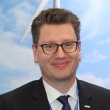14:30 - 16:00 The supply chain - thinking ahead!
Supply chain


Room: Hall F
This supply chain session looks at opportunities for mitigating risks by transferring offshore approaches to onshore operations. It explores how an industrialised non-EU country is preparing for wind ramp-up and how development of new technology can still use an existing supply chain.
You attended this session?
Learning objectives
Delegates will be able to:
- Explain how certification helps to ensure market compliance and technical risk mitigation;
- Describe how new product developments use established production processes;
- Elaborate on how the supply chain can contribute to lower levelised cost of energy;
- Explain that manufacturing surveillance can reduce risk wind farm loss of production;
- Describe the diversified supply chain of a non-EU high technology country.

Presenter

Co-authors:
Woebbeking Mike (1) F
(1) DNV GL, Hamburg, Germany
Presenter's biography
Biographies are supplied directly by presenters at WindEurope Summit 2016 and are published here uneditedMike Woebbeking is Service Area Leader and Head of the Certification Body Renewables Certification at DNV GL (DNV GL RC), the leading certification body for components, turbines and farms in wind and marine energy. He got his degree as a civil engineer from the Technical University of Hanover in Germany and is European / international welding engineer (EWE / IWE). He has been involved in the certification of wind turbines and the development of guidelines and standards in the field of wind energy for more than 15 years. Mike is secretary of DNV GL’s Wind and Marine Energy Committee of Experts, member of IEC TC88 as well as the IEC RE. Additionally he is chairman of the German Technical Committee “Wind Turbines” DKE K383 (national mirror-committee of IEC TC 88) and chairman of the European Technical Committee “Wind Turbines” CLC / TC 88.
Abstract
Procurement problems? Not this way - solutions for professionals.
Introduction
Component manufacturers often struggle to enter new markets or become part of the supply chain of OEMs. OEMs themselves have difficulties in selecting the right partners for their product development and series production. The presentation will focus on the issues and clearly describe solutions to overcome those. It shall include insights in daily work as certification body, details of relevant normative requirements and use of component certificates to overcome the problems.
Approach
The approach lasts from standard development to efficient certification processes, from joint industry projects to lessons learnt seminars, from recently issued certificates to 30 years of experience, from platform improvement to market entries.
Main body of abstract
The pressure on reduction of cost of energy is high in the renewable energy sector. Focusing on reducing costs increases the risk for safety, quality and reliability. Hence, the independent evaluation of a third party is of an even higher importance to ensure the highest level of safety, quality and reliability.
This presentation identifies services for component certification of onshore and offshore wind turbines and serves as a:
•facilitator to identify and apply relevant technical standards
•guidance for engineers from concept to serial production
•description to meet state-of-the-art requirements for modern wind turbines, and beyond
•common communication platform for describing the scope and extent of activities performed for certification of a wind turbine and its components
•contractual basis for certification of wind turbines and components
The conceptual and prototype stages of the development process are covered considering technology qualification and risk analysis. The interface to type certification of whole wind turbines and platforms is addressed. The certification services are adjusted to follow the wind turbine or component development phases from concept to serial production and beyond. These development phases may be supported during the wind turbine development by respective certification deliverables.
The main differentiators of this presentation are:
•more guidance and descriptions to facilitate application
•all wind turbine relevant topics addressed in one go
•all wind turbine development phases are supported and addressed
•certification may be tailored by adding multiple optional services, allowing more benefits
The benefits of applying this can be:
•independent approval of the wind turbine component to reduce own risk in developing and designing
•building of trust in the design and construction
•reducing costs by early detection of non-conformities
•confidence in technical integrity
•confirmation of requirements as stated by project developers, investors, operators, manufacturers, governmental and non-governmental organisations
•prove by an independent body to meet the national and international acknowledged state-of-the-art and to ease market entry
•utilise statements and certificates for authorisation by governmental institutions
•prove to investors or insurer that third party approval is successfully performed
•securing sustainable energy production throughout life-cycle
•minimising technical risks
•document stepwise the maturity of the wind turbine development project
•mitigate risks to environment and people
Component certification as a term used in this presentation covers e.g. major and minor components, systems, single parts or assemblies used in a wind turbine or attached to it. The full supply chain is addressed.
Conclusion
Solutions for professionals will be discussed and described. Confirmation of requirements as requested by project developers, investors, operators, manufacturers, governmental and non-governmental organisations due to prove by an independent body to meet the national and international acknowledged state-of-the-art and to ease market entry. Securing sustainable energy production throughout life-cycle and pro-actively mitigate risks to environment and people.
Learning objectives
The benefits of applying this in their own jobs and daily work amongst others can be:
•reduce own risk in developing and designing
•reducing costs by early detection of non-conformities
•confidence in technical integrity
•confirmation of requirements as stated by other parties
•meet the national and international acknowledged state-of-the-art
•ease market entry
•minimising technical risks
•document stepwise the maturity of the wind turbine development project
•mitigate risks to environment and people





Follow EWEA on: